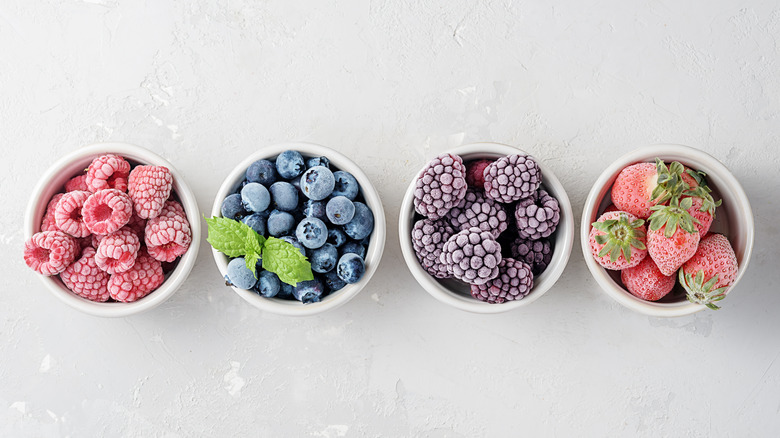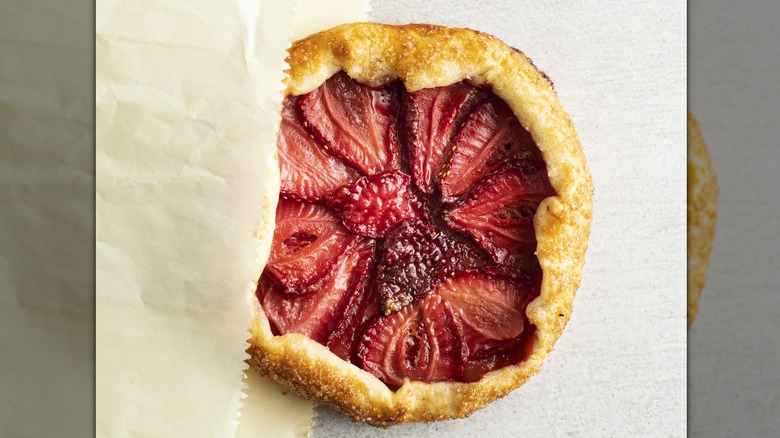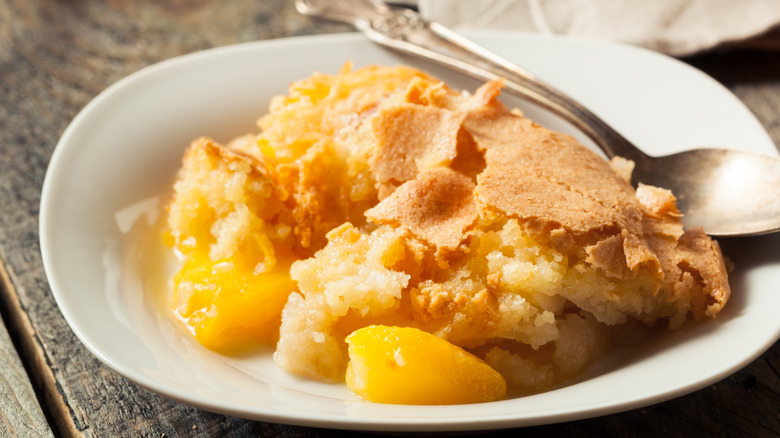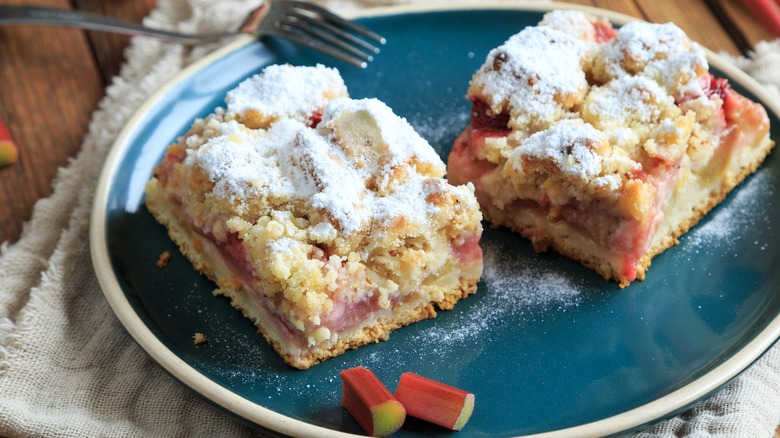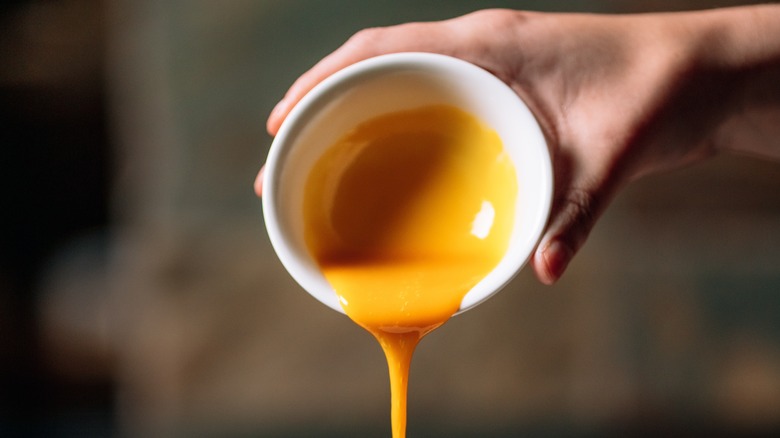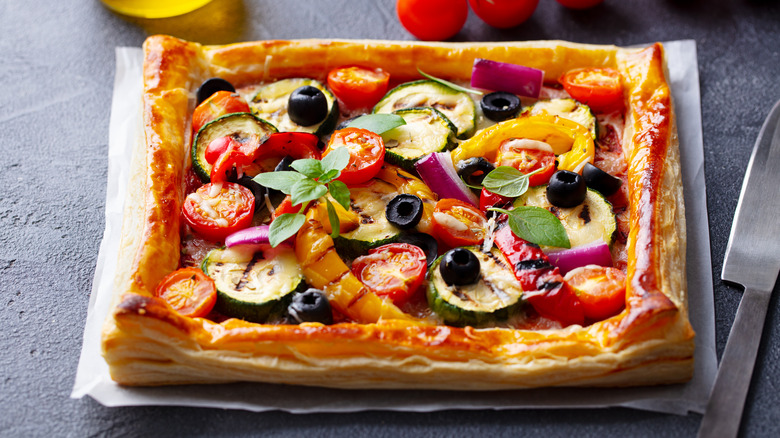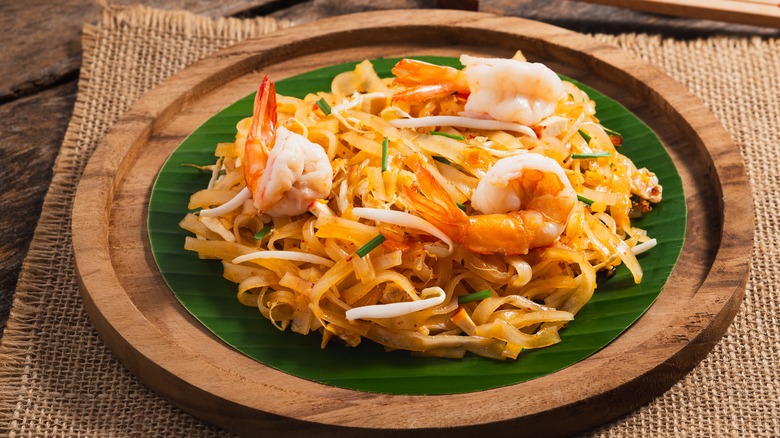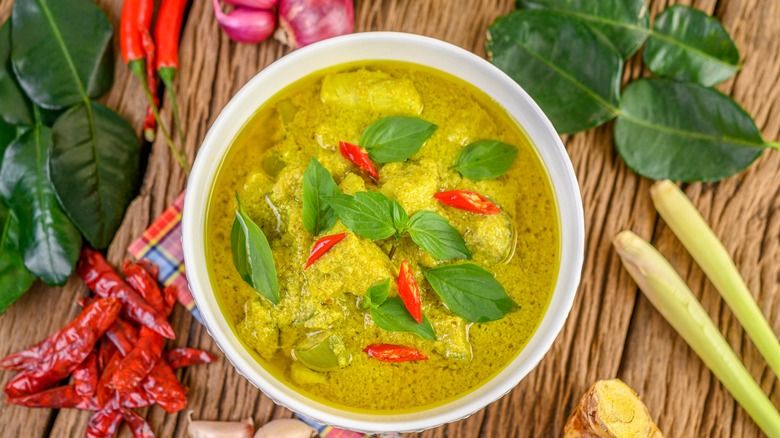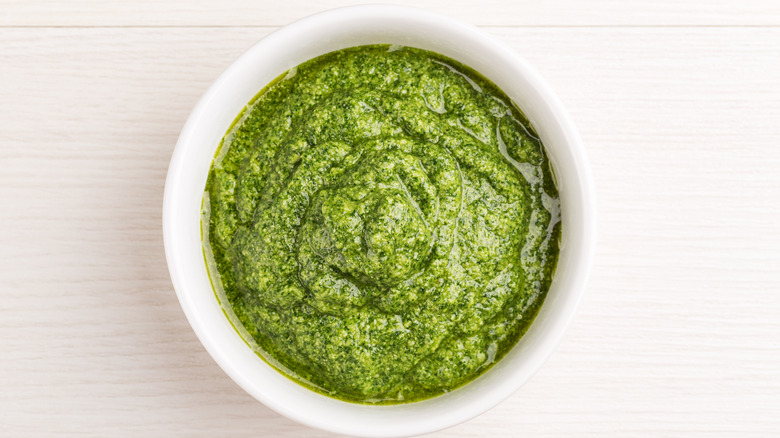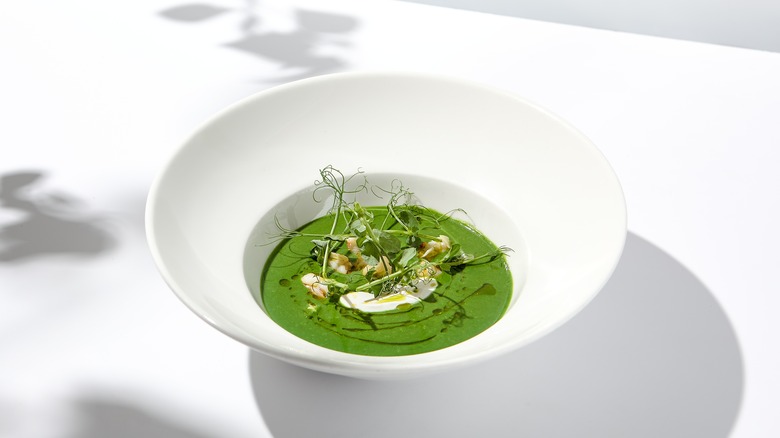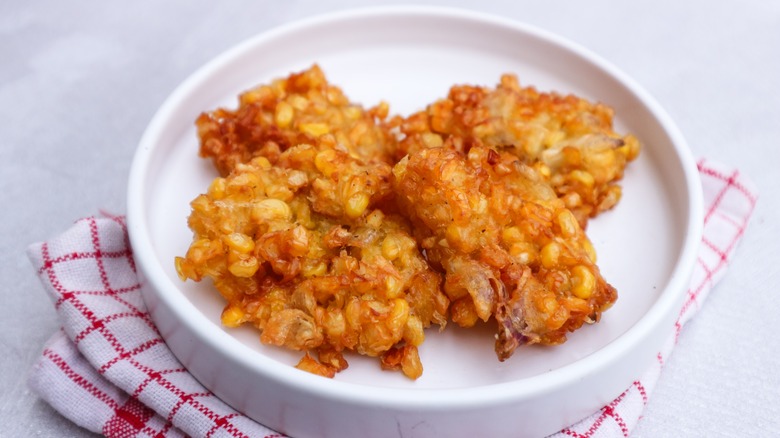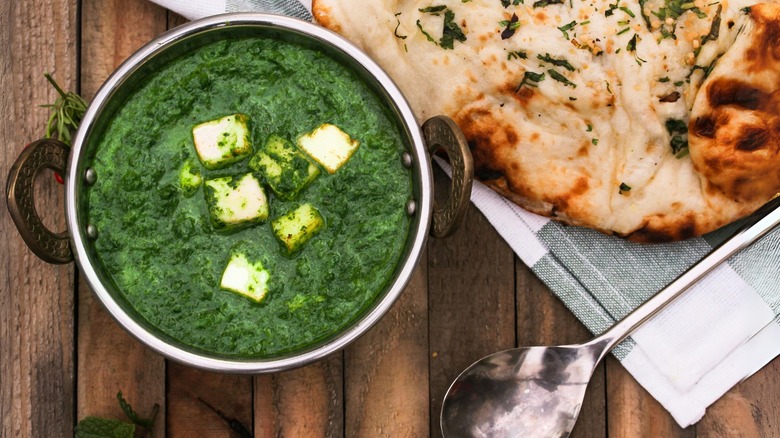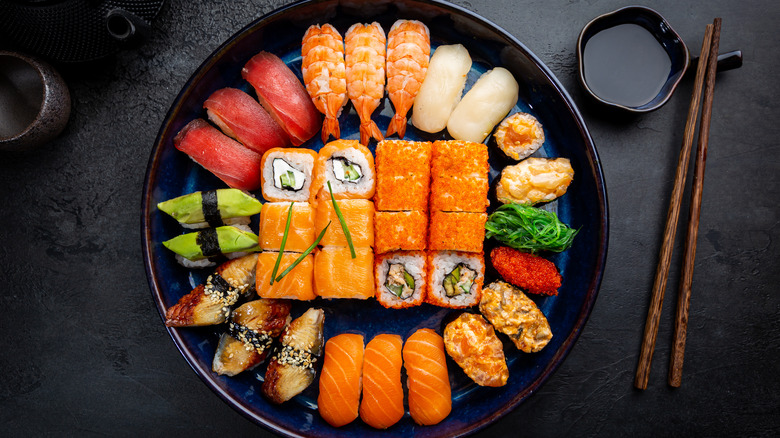12 Frozen Foods Chefs Always Have On Hand
Frozen foods don't have a lot of enthusiastic fans, but do they really deserve this reputation? You might think of soggy frozen broccoli or sad TV dinners, yet some frozen foods are pretty decent and some are just as good or better than fresh ones. In fact, they're good enough that there are some frozen foods chefs always have on hand.
I wanted to hear from culinary experts about the frozen foods that they use and think are worth recommending. I interviewed three trained chefs to get the lowdown on their freezer aisle must-haves. From favorites that many of us already have in our freezers, such as peas and corn, to lesser-used ingredients, like makrut lime leaves, there are all kinds of frozen ingredients you should be buying.
Frozen fruits and vegetables can be particularly good, because they're picked at their peak ripeness, rather than being harvested before they're ready so that they won't spoil during transit. However, not every piece of produce freezes well, so you still need to be discerning. Thanks to the experts who spoke to us, we can share the best foods to buy frozen and how you might want to use them.
Berries
"Berries like blueberries, strawberries, and raspberries are fantastic for buying frozen in the off-season," says chef Gigi Gaggero, former academic director at Le Cordon Bleu. "They are often flash-frozen at the peak of freshness, locking in nutrients and flavor," she adds. While you'll most commonly find everyday berry varieties frozen, there are many types of berries and you can occasionally buy more unusual ones in the freezer, such as gooseberries and loganberries.
Jon Butler, executive chef at Kiki's in La Quinta, agrees that frozen berries are a good choice because they're often flash frozen. Flash freezing is a process of quickly freezing food to minimize ice crystals that can ruin the texture. "Flash frozen fresh berries, when thawed out, are hard to distinguish from fresh," explains chef Galen Zamarra, a James Beard award winning chef who studied at the Culinary Institute of America.
If you're wondering what to do with your frozen berries, we have some expert-approved ideas. "Frozen berries are great for smoothies, baking, oatmeal, toppings for yogurts, and making coulis and sauces," Gaggero tells us. We also love finely grating berries straight from the freezer to make a super fruity shaved ice. You can eat it alone or with ice cream — it's one of the simplest desserts around.
Peaches
Peaches are a fan-favorite. We have so many peach recipes that we love, from pie and cobbler to salsa and salad. But, good fresh peaches aren't always available, which is where frozen peaches come into play. They're surprisingly tasty, as they're usually picked, processed, and quickly frozen when they're fully ripe and at their best.
Frozen peaches are something chef Jon Butler recommends because they're flash frozen and still have a pretty great texture when defrosted. "They can be made into a cobbler or pie very easily with minimal additional ingredients and work," he notes. So, it's simple to make some of the most popular peach recipes year-round.
Looking to branch out from the classics? "They can also be cooked down and thickened with pectin to create a jam or jelly very easily," Butler notes. This is a great way to experiment with homemade preserves without as much prep. Frozen peaches are peeled, halved or sliced, and have their stones removed, so they're easy to throw in a pot to make jam — or use in any recipe of your choice.
Rhubarb
It isn't always readily available, but if you can find frozen rhubarb, chef Galen Zamarra recommends you pick it up. He explains that, while it isn't a fruit, we use it like a fruit. "Making a compote or muffins with frozen rhubarb is great," he says. There are many other ways to use rhubarb, too. Rhubarb crumbles, pies, and cakes are all delicious. If you're not sure where to start, try this easy rhubarb cake recipe.
For those who haven't tried rhubarb, it grows out of the ground as the stalk of a plant with large leaves up top. The stalk is long and thick and can be found frozen in long pieces or smaller slices. For something that's often used in sweet baked goods, you might be surprised at how sour it is. That's why it's usually cooked with a healthy dose of sugar. But, it can even be used in some savory recipes, such as curries and sauces. The tart note it brings lends itself well to these kinds of dishes. Or, you might like to enjoy it in a different manner — "I like to eat it frozen like a popsicle," Zamarra tells us.
Any out-of-season fruits
"The advantage of frozen fruit is it generally was picked at peak ripeness, making it available year round so that you aren't limited to a brief season," Galen Zamarra remarks. We've listed a number of fruits that are always a good choice to buy frozen, but any fruit that's out of season is a chef-recommended buy. Although you can buy many fruits year-round, some of them just aren't as good when they're not in season. Out-of-season mangos, for instance, pale in sweetness and depth of flavor compared to ones that ripen during the peak season. In these cases, it pays to buy frozen, instead.
"Any fruit that you'd like to use that is out of season is better frozen than fresh," says Kiki's chef Jon Butler. "This is due to it being picked at its peak and then quickly frozen. This should be used primarily for cooked applications like pies and jams." So, although you might not get the same texture as you would with fresh fruit (frozen is often a little mushier), it's a more flavorful option for produce that isn't in its peak season. If you're throwing it in smoothies or making jams or coulis, the texture doesn't matter, anyway.
Puff pastry
Puff pastry is one of those things that you really don't need to make from scratch, unless you particularly want to have the experience of doing so. The reason? Chilled and frozen puff pastry is pretty great, actually. Except for keen bakers who want to learn to make puff pastry so there isn't a gap in their skills, there isn't much need to make it yourself — it's tricky and time consuming and nobody needs that.
"It's convenient to have in the freezer for making savory or sweet dishes like tarts, pies, turnovers, or appetizers," says chef Gigi Gaggero. "Frozen puff pastry saves time and effort compared to making it from scratch. This is my number one frozen purchase; who has time to make puff dough?" Even chefs say that it's usually not worth the time and effort of making it from scratch.
Frozen puff pastry usually comes in a block that needs to be rolled out. As such, you have to remember to remove it from the freezer with enough time to thaw and come up to room temperature before you need to roll it. Then, you can use it in just the same way as you would puff pastry made from scratch or chilled ready-rolled pastry.
Shrimp
If you've been buying shrimp from the chiller, it might be time to switch to frozen. "Getting fresh shrimp can be very difficult and the frozen product is exactly the same as what is used in most restaurants when thawed correctly," says Jon Butler. Some people are worried that frozen shrimp won't taste as good, but we have a chef's assurance that when it's handled properly, you don't have to worry about a lack of flavor. In fact, you've probably been served up frozen shrimp more times than you realize.
Gigi Gaggero mentions shrimp as one of the types of seafood she likes to buy from the freezer. Her reasoning is that it's surprisingly fresh. "Frozen seafood is also flash-frozen onboard fishing vessels, preserving its freshness and flavor," she explains. "It's convenient to have on hand for quick and easy meals; in some cases, it might be fresher than fresh fish," she adds. The other thing about buying fresh shrimp is that it quickly goes bad in the fridge. If you don't plan your meals right, it could spoil before you get around to eating it and that's a waste.
Bay leaves and lime leaves
Bay leaves and makrut lime leaves are commonly used in kitchens around the globe. Bay leaves have a more universal use in a range of cuisines, while makrut lime leaves are commonly used in Thai cuisine, especially curries. But, since these are much-loved dishes, these lime leaves are popular ingredients. Unless you're lucky enough to have access to fresh leaves, you probably use dried ones in your cooking, but frozen versions are a better choice.
Chef Galen Zamarra says they "don't improve with freezing but hold very well and are more aromatic frozen than dried." I've recently switched from dried makrut lime leaves to frozen ones in my signature green curry recipe and I've noticed a huge difference. Not only do they taste better, they blend into a paste more easily, so it doesn't turn out grainy — I'll never go back. Frozen bay leaves are also more aromatic and flavorful than their dried alternatives. You may need to go to specialty stores to find frozen bay leaves and lime leaves, but it's totally worth the trip.
Herbs
Fresh herbs can completely elevate a meal, turning it from basic to memorable with very little effort. But, when you can't get hold of fresh herbs — or you can't face a trip to the store — frozen herbs come in a close second. They're often better than dried herbs, especially soft herbs that don't hold up well to being dried, such as basil and parsley.
"Herbs like cilantro, parsley, and basil are great to buy frozen if you don't use them frequently," notes Gigi Gaggero. "Frozen herbs are typically chopped and frozen in small portions, allowing you to use what you need without worrying about the rest spoiling." Anyone who tends to waste fresh herbs by not using them before they go bad might appreciate the longevity of frozen ones.
How and where can you use them? In basically any recipe where you'd usually add fresh herbs. "They are perfect for adding flavor to dishes like soups, sauces, and marinades," Gaggero tells us. The only difference is you should add more than you would when using fresh herbs. They can lose some potency in the freezer, so it pays to go heavy-handed with them. They're also better cooked than raw because they can be soggy when thawed. People can make a range of mistakes when cooking with fresh herbs, and the same applies to frozen ones, so add them toward the end of the cooking time and choose the right ones to use for the dish of choice.
Peas
Often, we see frozen foods as a second-rate alternative to fresh ones. But, frozen peas might actually be better than fresh ones. This is because peas quickly deteriorate after being picked. If you buy fresh peas from the supermarket, they'll have likely been harvested at least a couple of weeks before you buy them. After all, they then have to be packaged and shipped. By this time, they stop being as good as they were when first picked. They can be starchy and mealy. The peas you buy from the freezer have been flash frozen within roughly a day of harvesting, so their texture remains at its best.
There are also potential health benefits to using frozen peas instead of fresh ones. "They are typically frozen immediately after harvest, preserving their nutrients," says Gigi Gaggero. So, never be embarrassed about picking up a bag of frozen peas — even chefs recommend it. And, it'll save you hours of shelling time, too. You can use frozen peas in all the same ways as fresh ones. Boil them as a side, stir fry them, blend them into soups, make a pea and mint smash. The list goes on.
Corn
Fresh corn is delicious, but all the shucking and cutting kernels from the cob can be frustrating. Sometimes you just don't have time for it. Then, there's canned corn, which isn't as crisp or bright-tasting as the fresh stuff. The answer is frozen corn. It has a much better texture and flavor than canned corn but with the same level of convenience. You don't even have to cook it before use — just defrost it and you're good to go.
Chef Gigi Gaggero tells us it's one of the vegetables she likes to buy frozen. "Frozen vegetables are convenient, have a long shelf life, and can be quickly added to soups, stir-fries, casseroles, or as side dishes in a pinch," she says, adding that they're great for weeknight meals. You can use frozen corn in many of the ways you'd use fresh or canned corn — try it in chowder, fritters, or cornbread, for starters. We love that it saves time without sacrificing quality. You won't regret making space for it in your freezer.
Spinach
Of all the vegetables you can buy frozen, spinach is one of the most reliable. Because this leafy green wilts in recipes, anyway, the fact that it comes out of the freezer a little soggy isn't an issue. It also goes a lot further than fresh spinach. If you've ever cooked down what seemed like a mountain of spinach, only to find that it shrinks to a laughably small quantity when wilted, it's time to try frozen. Spinach is wilted before freezing, so what you see is what you get — and it means that value-wise, it can't compare to the fresh stuff, it's so much cheaper frozen.
It also tastes great right out of the freezer. It needs a good squeeze to get rid of excess liquid, so you don't make your recipes too watery, but that's its only drawback. We love it in spinach-heavy dishes, such as saag paneer, spinach soup, and spinach and feta pastries. Gigi Gaggero mentions it as a favorite frozen vegetable of hers, due to its freshness and convenience.
"Frozen vegetables can be a great option for purées and soups — you can use what you need and put the rest back in the freezer," says Jon Butler. But, you don't have to just puree it. The frozen chopped variety (as opposed to frozen whole leaf) is great for any recipes that ask for chopped spinach. It's cut up way more finely than you'd be likely to manage by hand.
Fish
Fish might not seem like the obvious choice to buy frozen, but all our chefs recommended it. According to Gigi Gaggero, "Some fish fillets are good choices to buy frozen, especially if you don't live near the coast." It might seem like fresh fish is the way to go, but if you're not in a fishing area, frozen can actually be better.
"If you went to the Tokyo fish market, you might be surprised to see that most of the fish is frozen," Galen Zamarra remarks. "Fresh fish only lasts a few days, so freezing it is a good option — even for sushi." He explains that 90% of sushi is, in fact, prepared from frozen fish.
Some wild varieties, such as salmon, aren't always available year round, so this is where frozen fish comes in. "I choose frozen wild salmon over fresh farm salmon," says Zamarra. However, frozen fish doesn't cook quite the same as fresh. "If you sear or sauté it, moisture leaks out and will ruin any crust," Zamarra explains. "Instead try more gentle techniques, like poaching, steaming, or grilling."
